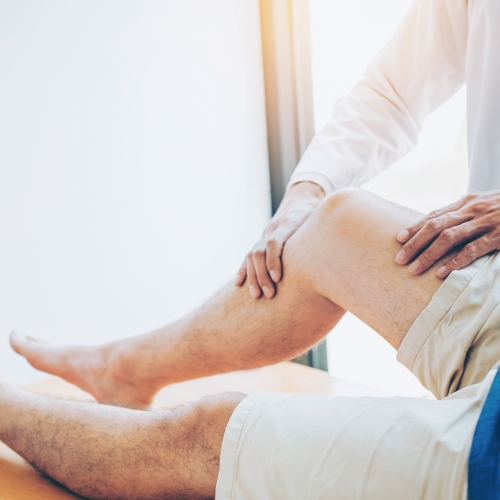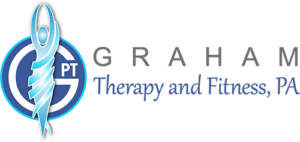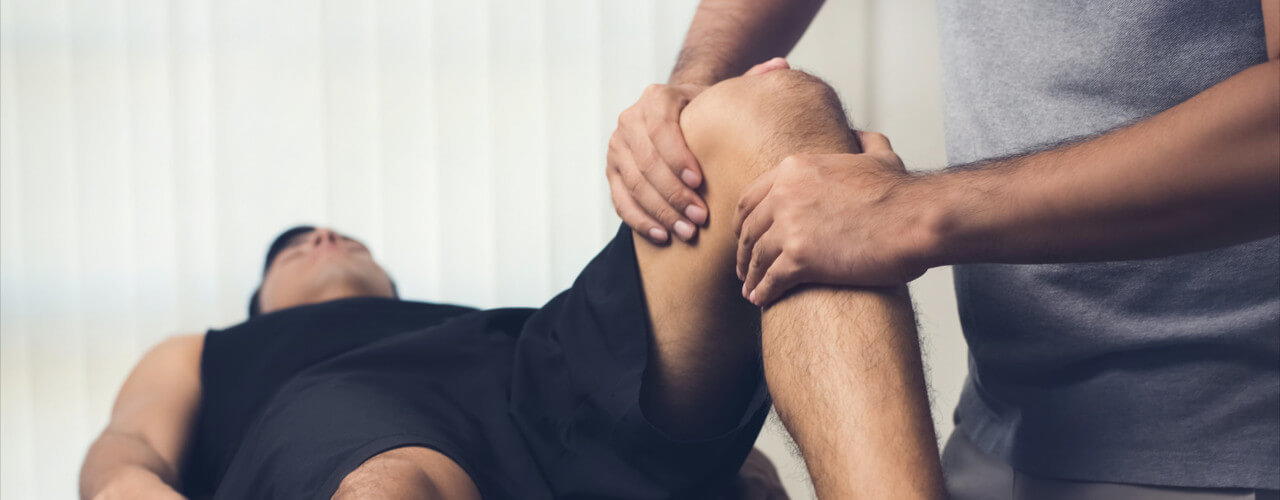
Do sharp pains in your knees make it difficult to get up in the mornings, move about during the day, and lie back down at night? Do your knees feel unstable and painful, as if they may buckle underneath you without warning? Knee joint pain can seriously interfere with your life; however, physical therapy can help get to the root of your problem safely and comfortably, without the drugs or surgery. Contact Graham Therapy and Fitness today to schedule your appointment with one of our Bethesda physical therapists!
Why do I have knee pain?
Your knee is a hinge joint, with primary forward-and-backward motions and also lower leg rotation, also known as tibial internal or external rotation. The knees allow you to stand, walk, run, and dance without falling over.
Pain felt in the knees may originate in the joints themselves. But it may also be a result of an underlying condition in another part of the body. For example, your knees are part of a kinetic chain, meaning they make up a combination of weight-bearing joints that must function with other parts of the body in harmony (such as the hips), in order for your body and posture to function properly. This means that while you may be feeling pain in your knees. The problem could actually be rooted in a different part of your body. If one part of the kinetic chain is out of balance, stress and deterioration may be placed on another.
What causes knee pain?
Overuse injuries, such as tendinitis and chronic muscle strain, are common in the knees because they are constantly in use. However, the knees may also be subject to acute injuries, such as sprains, strains, and dislocation.
Knee pain can also be affected by referred pain from a pinched sciatic nerve, as the nerve travels through your knees. Imbalances in your stance or gait may cause abnormal stresses and premature wear-and-tear in your knees, resulting in painful symptoms or arthritis.
Some conditions with the hips may also influence pain felt in the knees, as the hips are also a part of that same kinetic chain. For example, the Mayo Clinic states that cartilage injuries known as labral tears are specific to hip pain, while inflammation of the bursa sacs known as bursitis is a specific condition affecting the knee joint. However, painful injuries that cause instability in the hips can also affect the knees. Tight hip flexor muscles and weak gluteus medius muscles can cause the hip to rotate inward without you realizing it. This can cause painful problems such as iliotibial band friction syndrome or patellofemoral stress syndrome, as stress is put on the knee or kneecap.
ACL Injuries:
Perhaps one of the most common (and most painful) causes of knee pain is an ACL injury. The anterior cruciate ligament (ACL) is located in the knee and can be injured or torn when it is harshly twisted in the wrong way. ACL tears are especially common in athletes, including those who participate in sports such as gymnastics, football, soccer, tennis, or downhill skiing. All these sports require sudden stops and changes in direction. Making the risk higher for twisting the knee the wrong way and sustaining an ACL injury.
An ACL injury is painful and debilitating. Those suffering from this type of injury typically experience severe pain, swelling, limited range of motion, and instability when trying to bear weight. Fortunately, our Bethesda physical therapy services can help treat your ACL injury and provide some much-needed relief. According to GetPT1st, “research shows that 26% of non-contact ACL injuries could be prevented by specific exercise programs”. At Graham Therapy and Fitness, we are dedicated not only to helping you recover from your ACL injury. But we are also able to help you prevent further injuries from occurring in the future.
How will physical therapy relieve my knee pain?
The physical therapy treatments at Graham Therapy and Fitness can help to greatly reduce your knee pain. In many cases, it can even relieve it all together, sparing you the need for potentially harmful medication or surgical correction. Our Bethesda physical therapists will examine your knee for signs of misalignment or structural damage, in addition to examining your stance, posture, gait, and range of motion. After your physical exam is complete. Our physical therapists will prescribe a physical therapy plan for you, aimed at relieving unnatural stresses and strains, and normalizing your joint function.
You will be given targeted exercises designed for relieving knee joint pain and stabilizing weak knee issues. The exercises may vary depending on your condition; for example, research has demonstrated that those suffering from kneecap pain tend to respond better to exercises that focus on strengthening both the hips and knees, rather than just focusing on the knees alone.
Exercises
You may also be given exercises designed to strengthen the core, including your lower back muscle groups, lower abdominal muscle groups, or pelvic muscles. Core exercises are aimed at straightening your posture and equalizing the weight load on both sides of your body. Additional specialized treatments may also be added as our physical therapist deems fit, such as ice and heat therapies, laser therapy, massage therapy, or other soft tissue treatments that relieve pain and promote the healing of damaged knee tissues.
Once your knee pain has subsided and/or your injury has healed. Our physical therapists will likely recommend conducting several tests to gauge your injury risk, such as the Landing Error Scoring System (LESS). This is a jump-landing test, used to determine whether or not you are at high-risk for sustaining another non-contact ACL injury in the future.
It is time to take a stand against your knee pain. Contact Graham Therapy and Fitness today at Bethesda, MD to speak with one of our dedicated Bethesda physical therapists, and get started on the path toward long-lasting pain relief. Your knees will be glad you did!]
FAQs
What causes knee pain?
Your knees are hinge joints that allow for the forward-and-backward motions within the joint. The knee is one of the largest joints in your body, made up of a complex system of bones, tendons, and ligaments. Because of this, the knee can be easily injured due to overexertion or repetitive motions. Additionally, knee pain can be caused due to an underlying ailment. Some of the most common causes of knee pain are sprains, strains, fractures, tears, dislocation, tendinitis, bursitis, and arthritis.
How long should knee pain last?
Some knee pain can ease on its own. However, if you notice persistent pain, you should contact a physical therapist. Many people try to push through the pain that they feel; however, this can actually cause an issue to worsen and become more problematic. Sharp or dull pain in the knee should be paid attention to and not pushed through. If pain persists, especially for three months or longer, it is in your best interest to contact a physical therapist, as that can be an indication of a chronic condition.
Is walking good for knee pain?
Knee pain can be debilitating, making it difficult to walk, run, and move. While exercise can certainly help heal the root cause of your knee pain, it is important to make sure to only do so under the discretion of your physical therapist. Your treatment plan will largely consist of targeted exercises and manual treatments; however, additional pain relief modalities may also be added as your physical therapist deems fit. This will help you improve any problem areas and prevent further injury from occurring.
What is the best therapy for knee pain?
Our licensed physical therapists will examine your knee for signs of misalignment or structural damage, in addition to examining your stance, posture, gait, and range of motion. After your physical exam is complete, your physical therapist will prescribe a physical therapy plan for you, aimed at relieving unnatural stresses and strains, and normalizing your joint function. Treatment plans for knee pain typically include activity modification, manual therapy, strength and capacity training, range of motion restoration, graded exposure to previously painful activities, and patient education regarding activity modification.
Your Next Steps…
Request An Appointment
Receive A Custom Treatment Plan
Work Hard and Progress In Your Recovery
Recover & Enjoy Life Pain-Free!

